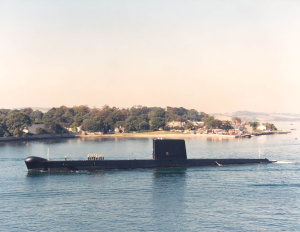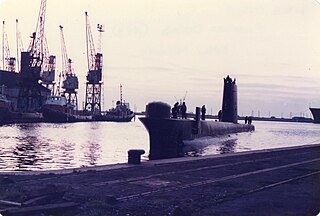
HMS Ocelot (S17) is an Oberon-class diesel-electric submarine which was operated by the Royal Navy.

HMS Onyx was an Oberon class submarine of the Royal Navy.

HMS Onslaught was a British Oberon-class submarine operated by the Royal Navy.

HMS Oberon was the lead ship of the Oberon-class submarines, operated by the Royal Navy.

HMS Odin was a British Oberon-class submarine operated by the Royal Navy.

HMS Opportune (S20) was an Oberon-class submarine of the Royal Navy.

HMS Otus was a Royal Navy Oberon-class submarine launched in 1962. She was decommissioned in the early 1990s and is now a naval museum in Germany.

HMS Olympus was an Oberon-class submarine that served in the Royal Navy, and later in the Canadian Forces as a submarine trainer.

HMS Osiris (S13) was an Oberon-class submarine that served in the Royal Navy.

HMS Oracle was an Oberon-class submarine of the Royal Navy.

HMS Orpheus was an Oberon-class submarine of the Royal Navy.

HMS Otter (S15) was an Oberon-class submarine of the Royal Navy.

HMS H7 was a British H-class submarine built by the Canadian Vickers Co, Montreal, Quebec, Canada. She was laid down on 19 May 1915 and was commissioned in June 1915. HMS H7 was sold in 1921. It had a complement of twenty-two crew members, a length of 171 feet (52 m), and a surfaced range of 1,600 nautical miles at 10 knots.

HMS H10 was a British H-class submarine built by the Canadian Vickers Co., Montreal. She was laid down on an unknown date and was commissioned in June 1915.

HMS H11 was a British H-class submarine built by Fore River Yard, Quincy, Massachusetts. She was laid down on an unknown date and was commissioned in 1915. H11 along with HMS H12 to HMS H20 were all built in America but were interned by the United States government until the United States entered World War I. H11 was sold on 20 October 1920 in Dover and lost on tow to the breaker's yard. The wreck was identified 2007.

HMS H12 was a British H-class submarine built by Fore River Yard, Quincy, Massachusetts. She was laid down on an unknown date and commissioned in 1915. HMS H12 along with HMS H11 and HMS H13 to HMS H20 were all built in America but were interned by the United States government until the United States entered World War I. HMS H12 was sold in April 1920 in Dover.
HMS H52 was a British H class submarine built by HM Dockyard, Pembroke Dock. She was laid down on an unknown date, launched on 31 March 1919 and commissioned on 16 December 1919, the last Welsh-built fighting ship to enter the British Royal Navy.

HMS H47 was a British H class submarine built by William Beardmore and Company, Dalmuir. She was laid down on 20 November 1917 and was commissioned on 25 February 1919. It had a complement of twenty-two crew members. HMS H47 was sunk in a collision with British L class submarine L12 off Milford Haven, Wales on 9 July 1929. Twenty one of the crew were lost with only three survivors.

HMS H22 was a British H class submarine built by Vickers Limited, Barrow-in-Furness, as part of the Batch 3 H class submarines. She was launched on 14 November 1917 and was commissioned on 6 November 1918.
HMS H24 was a British H-class submarine built by Vickers Limited, Barrow-in-Furness, as part of the Batch 3 H-class submarines. She was launched on 14 November 1917 and was commissioned on 30 April 1918.















